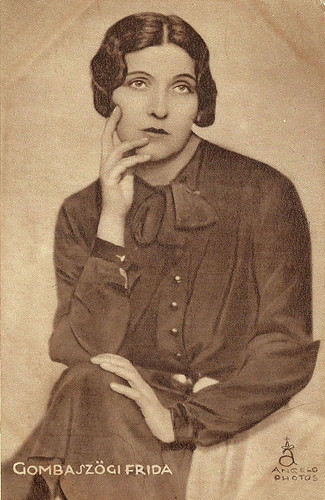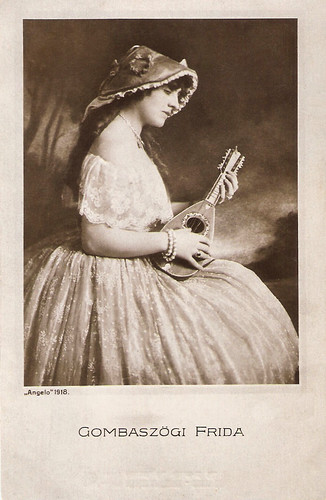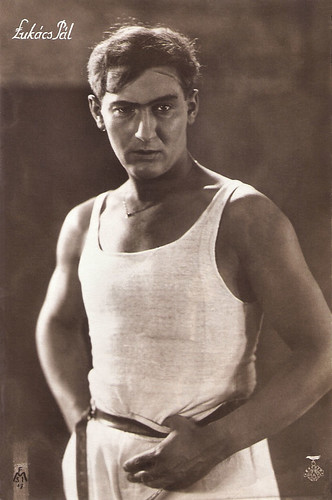Frida Gombaszögi (1890–1961) was the first Hungarian actress who represented the modern acting style in plays by Molnar, Chekhov and Gorky. During her long and impressive career, she also appeared in silent films and one sound film.
![Frida Gombaszögi]()
Hungarian postcard. Publisher: Globus, Budapest. Photo: Angelo Photos. Collection: Didier Hanson.
Frida Gombaszögi was born Friderika Vilma Grün in Budapest, Hungary in 1890. Her sisters Ella, Irèn en Margit would all become actresses. Ella became a comic actress, but Frida specialised in drama.
In 1909 Frida started her stage career after the completion of the Színiakadémián (Hungarian Theatre Academy). She was signed by László Beöthy, director of the Magyar Színház (Hungarian Theatre).
With her sophisticated appearance, her polished movements and cultured speech culture, and her intelligent, expressive play, she created modern dramatic heroines in plays by Ferenc Molnar, Henrik Ibsen, Anton Chekhov and Maxim Gorky. Between 1916 and 1933 she was a member of the Vígszínház (Comedy Theatre).
During that period, she also played in silent Hungarian films. She made her film debut opposite Victor Varconi in Farkas/The Wolf (1917), based on a play by Ferenc Molnar in which she had appeared on stage. The film was directed by Mihály Kertész, who would later become known as Hollywood director Michael Curtiz.
In 1918, she starred in A Szerelem bolondjai/The Fools of Love (Carl Wilhelm, 1918) and another Molnar adaptation, A testör/The bodyguard (Alexander Antalffy, 1918).
The following year, she co-starred with her sister Ella Gombaszögi in Átok vára/Bane's castle (Károly Lajthay, 1919) and Sundal/Sund (Károly Lajthay, 1919). The two sisters also appeared in Vorrei morir/I Want to Die (Károly Lajthay, 1919). The film starred Károly Mihályfi, and the Gombaszögi sisters only played supporting parts in it.
Her final silent film was Tláni, az elvarázsolt hercegasszony/False, he is an enchanted prince (Károly Lajthay, 1920). In this film she played the female lead opposite Pál Lukács, who would later become a renowned, Oscar winning Hollywood star under the name Paul Lukas.
![Frida Gombaszögi]()
Hungarian postcard by Reinitz Jòzsef, Budapest / Terjeszti Gonda Oszkàr, Budapest. Photo: Angelo, 1918.
In 1919, Frida Gombaszögi was shot by a young man, probably a fan, who then committed suicide. The actress was severely injured in her face, and for a long time it was unsure if she could ever return to the stage. Her first appearance after healing was received with a loud celebration. The cosmetic-dermatologist Ernő László had almost eliminated all traces of the injury. Frida's sister, Irén later married László and in 1939 the couple moved to the US.
Frida Gombaszögi was married three times. Her first husband was stage and film actor Rajnai Gábor, whom she married in 1909. They divorced in 1918 but they would stay friends during her whole life.
In 1922, she married journalist and publisher Miklós Andornak, who was killed in 1933 by a bomb. Frida Gombaszögi retired from the stage and became the owner and CEO of her husband's Atheneum Publishing company and Az Est (The East) newspaper.
Her third husband was writer, poet, journalist, producer, playwright and politician Jenő Heltai.
After the war she worked again for the Vígszínház and also for the prestigious Nemzeti Színház (National Theatre). She also worked as a drama teacher at the Színművészeti Főiskola between 1953 and 1956.
In 1956 she also appeared in a sound film, Az élet hídja/The Bridge of Life (Márton Keleti, 1956).
Her career was again interrupted by the political manoeuvres of the communist regime and she had to leave Budapest and work in a provincial theatre. At the end of her life she also worked for television.
Why she did not appear in more films is not clear. Her sister Ella Gombaszögi was a well known film actress during the 1930s.
Frida Gombaszögi died in 1961 in Budapest. She was 70.
![Paul Lukas]()
Paul Lukas. Hungarian postcard by FMSI, no.17. Photo: Korvin / Joe May Film.
Sources: Takács István (szineszkonyvtar.hu - Hungarian), György Székely (Magyar színházművészeti lexikon - Hungarian), Wikipedia (Hungarian) and IMDb.

Hungarian postcard. Publisher: Globus, Budapest. Photo: Angelo Photos. Collection: Didier Hanson.
Enchanted Prince
Frida Gombaszögi was born Friderika Vilma Grün in Budapest, Hungary in 1890. Her sisters Ella, Irèn en Margit would all become actresses. Ella became a comic actress, but Frida specialised in drama.
In 1909 Frida started her stage career after the completion of the Színiakadémián (Hungarian Theatre Academy). She was signed by László Beöthy, director of the Magyar Színház (Hungarian Theatre).
With her sophisticated appearance, her polished movements and cultured speech culture, and her intelligent, expressive play, she created modern dramatic heroines in plays by Ferenc Molnar, Henrik Ibsen, Anton Chekhov and Maxim Gorky. Between 1916 and 1933 she was a member of the Vígszínház (Comedy Theatre).
During that period, she also played in silent Hungarian films. She made her film debut opposite Victor Varconi in Farkas/The Wolf (1917), based on a play by Ferenc Molnar in which she had appeared on stage. The film was directed by Mihály Kertész, who would later become known as Hollywood director Michael Curtiz.
In 1918, she starred in A Szerelem bolondjai/The Fools of Love (Carl Wilhelm, 1918) and another Molnar adaptation, A testör/The bodyguard (Alexander Antalffy, 1918).
The following year, she co-starred with her sister Ella Gombaszögi in Átok vára/Bane's castle (Károly Lajthay, 1919) and Sundal/Sund (Károly Lajthay, 1919). The two sisters also appeared in Vorrei morir/I Want to Die (Károly Lajthay, 1919). The film starred Károly Mihályfi, and the Gombaszögi sisters only played supporting parts in it.
Her final silent film was Tláni, az elvarázsolt hercegasszony/False, he is an enchanted prince (Károly Lajthay, 1920). In this film she played the female lead opposite Pál Lukács, who would later become a renowned, Oscar winning Hollywood star under the name Paul Lukas.

Hungarian postcard by Reinitz Jòzsef, Budapest / Terjeszti Gonda Oszkàr, Budapest. Photo: Angelo, 1918.
Killed by a Bomb
In 1919, Frida Gombaszögi was shot by a young man, probably a fan, who then committed suicide. The actress was severely injured in her face, and for a long time it was unsure if she could ever return to the stage. Her first appearance after healing was received with a loud celebration. The cosmetic-dermatologist Ernő László had almost eliminated all traces of the injury. Frida's sister, Irén later married László and in 1939 the couple moved to the US.
Frida Gombaszögi was married three times. Her first husband was stage and film actor Rajnai Gábor, whom she married in 1909. They divorced in 1918 but they would stay friends during her whole life.
In 1922, she married journalist and publisher Miklós Andornak, who was killed in 1933 by a bomb. Frida Gombaszögi retired from the stage and became the owner and CEO of her husband's Atheneum Publishing company and Az Est (The East) newspaper.
Her third husband was writer, poet, journalist, producer, playwright and politician Jenő Heltai.
After the war she worked again for the Vígszínház and also for the prestigious Nemzeti Színház (National Theatre). She also worked as a drama teacher at the Színművészeti Főiskola between 1953 and 1956.
In 1956 she also appeared in a sound film, Az élet hídja/The Bridge of Life (Márton Keleti, 1956).
Her career was again interrupted by the political manoeuvres of the communist regime and she had to leave Budapest and work in a provincial theatre. At the end of her life she also worked for television.
Why she did not appear in more films is not clear. Her sister Ella Gombaszögi was a well known film actress during the 1930s.
Frida Gombaszögi died in 1961 in Budapest. She was 70.

Paul Lukas. Hungarian postcard by FMSI, no.17. Photo: Korvin / Joe May Film.
Sources: Takács István (szineszkonyvtar.hu - Hungarian), György Székely (Magyar színházművészeti lexikon - Hungarian), Wikipedia (Hungarian) and IMDb.